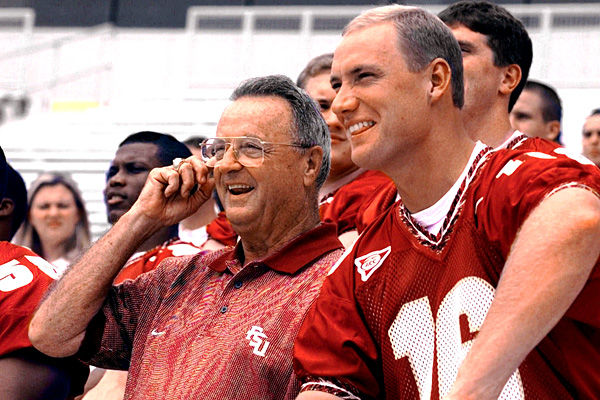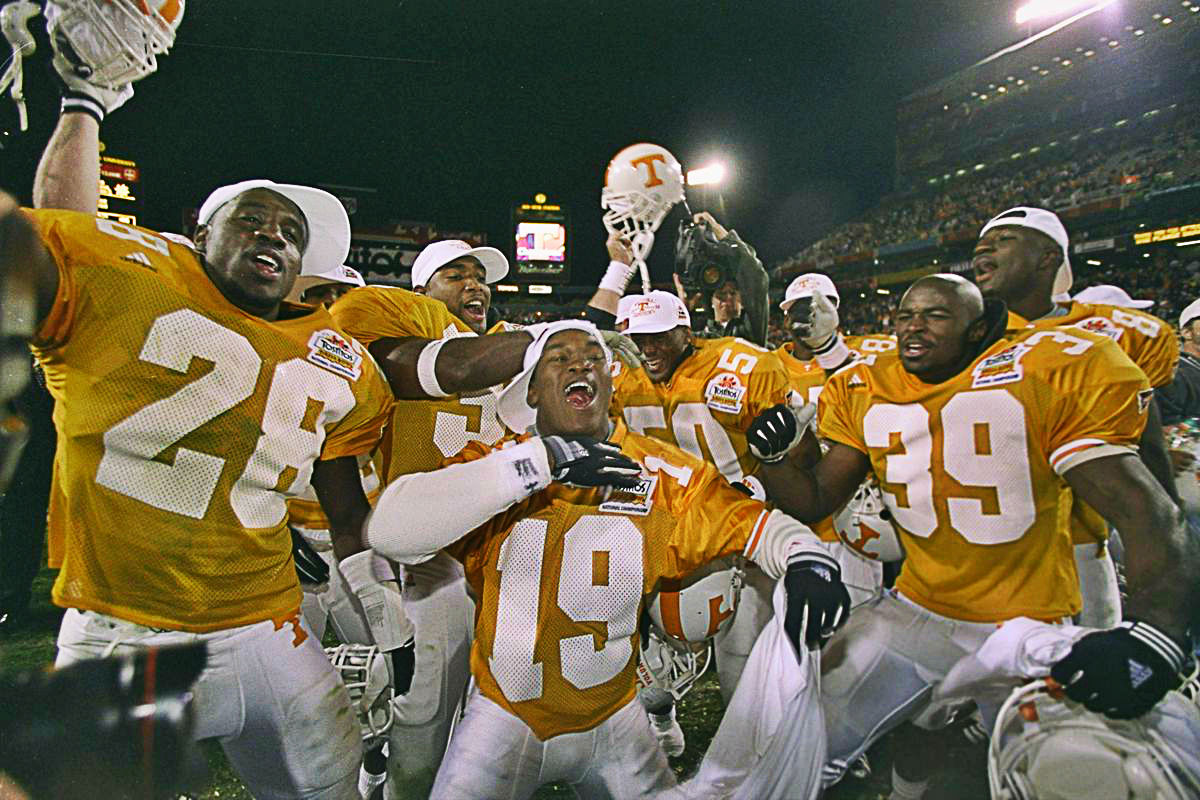In the first installment of College Football Season Throwback we went all the way back to the 1994 season and the dawning of a Nebraska dynasty. This next part fast forwards 4 years to the opening up of a new era of college football that would go on to completely transform the game all across the country for the next 15 years.
Welcome to the Bowl Championship Series era!
What’s Going On?
For the year 1998…the Monica Lewinsky Affair story broke, the “Unabomber” was sentenced to life in prison, the International Criminal Court was established, U.S. embassies were bombed in Tanzania and Kenya, and Google Inc. was founded.
The Winter Olympics in Nagano began, France won the World Cup on their home soil, Mark McGwire would go on to hit 70 home runs and break Henry Aaron’s MLB record, the Denver Broncos were defending NFL champions, and the Yankees would sweep the Padres in the World Series.
“Titanic” won the Best Picture at the Oscars, “Armageddon” was the highest grossing movie of the year with over $553 million, the Next song “Too Close” was the highest selling single, the “Titanic” soundtrack was the highest selling album, Trae Young was born, and Frank Sinatra died.
The Set Up
As we discussed in the ’94 look back the game of college football was desperately trying to line up the No. 1 and No. 2 teams to play each other in the post-season and prevent split national champions. The newly introduced Bowl Alliance in 1995 eventually failed as Nebraska and Michigan split the title in 1997 which led to the most serious negotiations to date for a new system in the lead up to the 1998 season.
Enter, the Bowl Championship Series.
The biggest breakthrough–and last remaining stumbling block for a “guaranteed” champion–was the Rose Bowl releasing the Big Ten and Pac-10 champions if necessary to create a national title matchup.
This changed everything.
The original BCS logo.
Although things would change for the 2007 season, at first the BCS Championship Game rotated among the Rose, Sugar, Fiesta, and Orange bowls. Thus, leading to these bowls becoming (and now incorrectly labeled with the playoff system) known as “BCS” bowls.
The very first BCS rules were fairly simple before they later became more complicated:
*No more than 2 teams from a conference could receive BCS bowl berths.
*The top 2 teams in the BCS poll played in the BCS Championship Game.
*Champions from the “Automatic Qualifying” conferences received berths to a BCS bowl, including the ACC, Big East, Big 12, Big Ten, Pac-10, and SEC. This left 2 spots remaining for other teams.
*The “Notre Dame rule” allowed the Fighting Irish a BCS berth merely with a top 8 finish.
*After filling the berths from the six automatic qualifiers, the remaining spots were to be filled by “at-large” bids from FBS teams in the Top 14 who had at least 9 wins with the stipulation being the individual bowl committees made the selection. That last part is important.
*Bowl tie-ins remained in place, including: Rose Bowl (Big Ten/Pac-10), Sugar Bowl (SEC), Orange Bowl (ACC), and Fiesta Bowl (Big 12) while the Big East did not have a bowl attachment.
*The BCS was computed with a poll average (AP & Coaches), computer average (3 different at first), plus strength of schedule, margin of victory, and losses were part of the formula that created a final point tally.
Heading into 1998 the AP Top 5 pre-season teams were Ohio State, Florida State, Florida, Nebraska, and Michigan. Three of these teams were at least co-champions of their conference while 3 would make it to the inaugural BCS bowl games. After an incredible run in the 90’s Nebraska fell back down to earth in ’98 with 4 losses.
No programs moved up or down from I-A football for 1998, although Army moved to Conference USA where they’d stay for 7 seasons (winning a grand total of 13 games!) before going back to being an independent.
Important rule changes ahead of ’98 included backward passes now being allowed to be advanced by the defense and helmet visors had to be clear and no longer hide a player’s eyes.
Recruiting
The top 5 in the recruiting team rankings for 1998 according to Tom Lemming were Michigan, UCLA, Notre Dame, Alabama, and Florida State.
The Wolverines were led by quarterback Drew Henson, running back Justin Fargas, and receiver David Terrell. Henson famously battled a guy named Tom Brady for snaps, Fargas looked like a bust at running back, moved to safety, then later transferred to USC before becoming a solid tailback with the Raiders, while Terrell left early after a 3-year All-American career to become a first round pick.
The ’98 class was also known for a pair of other prominent quarterbacks. Carson Palmer struggled for a while at USC before eventually winning the Heisman in his senior season. Michael Vick redshirt and then played 2 sensational years at Virginia Tech before being the No. 1 overall pick in the 2001 NFL Draft.
Other feature recruits were running back Deshaun Foster for UCLA and tight end-turned-defensive end Julius Peppers for North Carolina.
Notre Dame’s highly touted class was led by the likes of Arnaz Battle, Tony Fisher, Mike McNair, David Givens, Anthony Weaver, Carlos Pierre-Antoine, Rocky Boiman, and Cliff Jefferson.
Battle, Fisher, Givens, Weaver, and Boiman were all good players. Pierre-Antoine was okay but never lived up to his hype, Cliff Jefferson was a much maligned corner, while McNair was one of the biggest busts of the post-Holtz era.
The ’98 class ended up being best known for a soccer player who walked on in 1999 and became an All-American corner in 2001: Shane Walton.
The Regular Season
The first year of the BCS had one of the more wild regular seasons in college football history.
Pre-season No. 1 Ohio State spent the first 9 weeks of the season in the top spot of the rankings before blowing a 15-point lead to Nick Saban-led Michigan State. It would be the Buckeyes only blemish of the season and as they finished No. 1 in S&P a huge missed opportunity for an elusive John Cooper national title.
The Big Ten found itself with a 3-way tie at the top of 1-loss teams. Ohio State beat Michigan, Michigan beat Wisconsin, but Wisconsin and Ohio State didn’t play each other.
Texas A&M 14 vs. Florida State 23 [Giants Stadium]
Tennessee 34 at Syracuse 33
Michigan State 28 at Ohio State 24
Florida 17 at Tennessee 20 (OT)
Florida 12 at Florida State 23
Nebraska 30 at Kansas State 40
UCLA 45 at Miami 49
Wisconsin 10 at Michigan 27
Arkansas 24 at Tennessee 28
Michigan 16 at Ohio State 31
Florida State was sewing the seeds of their eventual 1999 National Championship and opened the season beating eventual Big 12 Champion Texas A&M in New Jersey. They’d drop a game to middling NC State the following week only to dominate the rest of their schedule, including getting past Florida in the regular season finale.
Georgia Tech was no slouch, either. They lost their opener to Boston College but finished tied atop the ACC with Florida State, although the Seminoles won the tie-breaker beating them easily head-to-head.
The Big 12 had a super fun year. Kansas State led the nation in scoring at 48 points per game and went through the regular season undefeated, ending their 29-game(!!) losing streak to Nebraska in the process. In total, the Big 12 would have 5 teams finish inside the Top 21 in the polls.
Out west, UCLA started 10-0 with 3 super close calls against Oregon, Stanford, and Oregon State which they all escaped. They were scheduled to open the season at Miami but Hurricane Georges caused its cancellation. Except, in October the teams agreed to play the week after the regular season ended. The Bruins promptly lost on a controversial late fumble to a Miami team that was defeated by 53 points the prior week versus Syracuse.
Arizona–with first year OC Dino Babers–was quite awesome. The were blown out by UCLA and lost the conference title as a result but otherwise never lost.
Tulane had a guy named Rich Rodriguez in his second year as OC who led the Green Wave to their highest scoring season ever with no losses. However, their severely weak schedule kept them well away from any BCS Bowl bid.

What if Weinke never gets hurt in 1998?
We can’t forget about Air Force who was a 1-point loss to TCU from having an undefeated season themselves.
Tennessee, no doubt, was a team of destiny and one of college football’s greatest examples of the Ewing Theory as ’98 was their first season without the departed No. 1 overall drafted quarterback Peyton Manning.
The Vols sneaked past Syracuse in the opener on a last-second field goal (senior Donovan McNabb-led Orange lost 4 games still a sore subject in upstate New York), beat Florida in overtime the following week due to a missed Gator field goal, and in mid-November as they finally rose to No. 1 for the first time in 42 years the Vols were gifted a fumble (I implore you watch the video above) while trailing with under 2 minutes to came back and beat undefeated Arkansas.
Championship week was maybe the craziest day in recent memory. The aforementioned upset of UCLA took place, Texas A&M upset undefeated Kansas State in the Big 12 title game, and Tennessee beat Mississippi State (the Bulldogs’ lone league title game appearance to date) in the SEC Championship in maybe the weakest year ever for the SEC West (33 combined losses by the 6 programs).
What of the Irish?
Beating defending co-champion Michigan to open the season was awfully nice. Getting their doors blown off by Michigan State the next week wasn’t very nice. The team rebounded to win their next 8 games against a soft schedule only to bomb out of the BCS race with a 10-0 loss at USC in the regular season finale.
The Irish lost by 7 points in the Gator Bowl to the aforementioned quality Georgia Tech team. Finishing at No. 28 in S&P it was a really unsatisfying 9-3 season marred by a lot of offensive problems, a sign of things to continue as the new century approached.
Bowl Season
With the 3-way tie in the Big Ten the league selected Wisconsin for the Rose Bowl using their rule of the team that had gone the longest without making it to Pasadena. The Badgers would face the Pac-10 champion UCLA Bruins now reeling off their Miami defeat.
Kansas State got royally screwed in 1998. Despite finishing 3rd in the final BCS poll (they didn’t drop from this spot after losing the Big 12 title game which is crazy), the Wildcats didn’t get a BCS bowl invite since Texas A&M took the Sugar Bowl bid as Big 12 champions while the Sugar Bowl picked #4 Ohio State and the Orange Bowl picked #8 Florida as at-large bids instead.
Sugar: #4 Ohio State 24 vs. #6 Texas A&M 14
Orange: #8 Florida 31 vs. #15 Syracuse 10
Rose: #9 Wisconsin 38 vs. #5 UCLA 31
The Buckeyes beat the Aggies to cement their status as the best team of the year that didn’t win it all, Florida crushed the underachieving Big East champion Syracuse team, and UCLA collapsed further while losing to Wisconsin.
For what it’s worth, Kansas State lost in the Alamo Bowl to unranked Purdue after quarterback Drew Brees led a game-winning touchdown drive with less than 90 seconds remaining.
Fiesta: #1 Tennessee 23 vs. #2 Florida State 16
Tennessee surely was a team of destiny as they were able to play Florida State in the first BCS Title Game and the Seminoles were without quarterback Chris Weinke who was out with an injury suffered against Virginia a few games back. Florida State was still a 5.5 point favorite in Vegas, though.
The Vols punted on their first series, only to see their drive extended by a roughing the punter penalty and eventually miss a field goal. Tennessee took a 7-0 lead in the 2nd quarter after a roughing the kicker call extended that drive, plus immediately followed that up with a pick six to go up 14-0.
FSU scored later before the half (missed PAT) and Sebastian Janikowski (still in the NFL!) hit a field goal to cut it to 14-9. The Vols added a touchdown (missed PAT) and a field go to go up 23-9 before Florida State cut it to 23-16 late. Travis Henry fumbled for Tennessee with under 2 minutes remaining–right after a converted 4th & 1 put the ball deep in FSU territory quite a gutsy call for January 1999–but a Marcus Outzen interception sealed the game for the Volunteers.
This was supposed to be legendary broadcaster Keith Jackson’s last game of his career, but he would un-retire that fall and work a much more limited schedule before officially retiring after the 2006 Rose Bowl.
Heisman Controversy?
As far as these things go, Ricky Williams literally and figuratively ran away with the Heisman in one of the easiest selections in modern history. He would finish with the 3rd most rushing yards in a season (at the time), tied for the 2nd most rushing touchdowns in a season, and would go on to break the career NCAA rushing record in the rivalry game against A&M.
In another year, Michael Bishop maybe could’ve challenged for the award. With the nation’s top offense he totaled 3,592 yards with 37 touchdowns and only 5 interceptions.
Heisman Voting
Texas RB Ricky Williams – 2355
Kansas State QB Michael Bishop – 792
UCLA QB Cade McNown – 696
Kentucky QB Tim Couch – 527
Syracuse QB Donovan McNabb – 232
McNown was largely a product of being the quarterback on a hyped pre-season team that started 10-0 although looking back his numbers aren’t particularly Heisman-worthy.
Tim Couch threw the ball all over the place (553 attempts in 1998!) and at least made the Cleveland Browns fall in love with him. Still, he threw 15 interceptions for a .500 SEC team that had a hard time stopping other teams.
It’ll always be a ‘what if’ for Syracuse and McNabb. They nearly beat the eventual National Champions, beat Michigan, Virginia Tech, and Miami but had too many blemishes on their record for McNabb to climb higher than 5th for the Heisman.
The Aftermath
The so-called “Kansas State Rule” was adopted by the BCS for 1999 which stated a No. 3 seed (or No. 4 seed if No. 3 is an automatic qualifier) is assured a BCS bowl, meaning the scheming bowls couldn’t avoid a team if they preferred another program. For maximum cruelty, Kansas State finished 10-1 following the ’99 regular season, didn’t win the Big 12, finished No. 6 in the BCS standings, only to get passed over for a BCS Bowl by No. 8 Michigan. The Wildcats would beat Washington in the Holiday Bowl to finish 11-1.
The honeymoon for the BCS didn’t last long, if it ever existed. The undefeated ’99 season for Marshall–this was 2 years after Randy Moss left but Chad Pennington was a senior–who debuted at No. 14 and never rose higher than No. 12 in the BCS rankings was another strong suggestion non-AQ conference teams would be severely discriminated against in the system. The Thundering Herd finished a dominant +326 in point differential but were relegated to the Motor City Bowl.
In the future, the BCS would make changes to accommodate a scenario like this for the lower conferences but never killed the cries for a playoff system.






Gotta correct you here. Kansas State lost to Purdue in the Alamo Bowl after the 1998 season.
Boiler Up 😉
Just before the BCS title game recap:
“For what it’s worth, Kansas State lost in the Alamo Bowl to unranked Purdue after quarterback Drew Brees led a game-winning touchdown drive with less than 90 seconds remaining.”
Oh you’re right! I misread the part about them losing to Washington in the Holiday Bowl. My bad.
Oh god that Arkansas fumble is brutal.
History doesn’t really remember who you beat, just the title. Between your synopsis of that UT team and the Arkansas game that team was not the best team in the country but 20 years later they are remembered as champs (when was their last title before that??) and don’t carry around that narrative
We have gotten stuck playing 2 of the top 5 teams of the this decade in our national title playoff/appearances. Why couldn’t have we gotten k state or the 2012 Ohio state team, I would have taken backing in to a title. History doesn’t really remember
‘History doesn’t really remember’ is a great title for a book.
*Oh God, that Arkansas fumble gives me flashbacks of Everett Golson vs. Arizona State
Yeah, but you forget Golson brought the Irish back to the brink of winning before hitting Robinson on the numbers, bounced off his chest for a deflected pick six. Golson was a heck of a qb who gets slammed gratuitously. I think Kelly got in his head and messed him up.
I doubt anyone will see this at this point, but as a bowl nerd I have to issue a small correction – the Big 12 was linked with the Fiesta Bowl, not the Sugar, in the BCS era. A&M was in the Sugar in 98 because the Fiesta was the BCS title game.